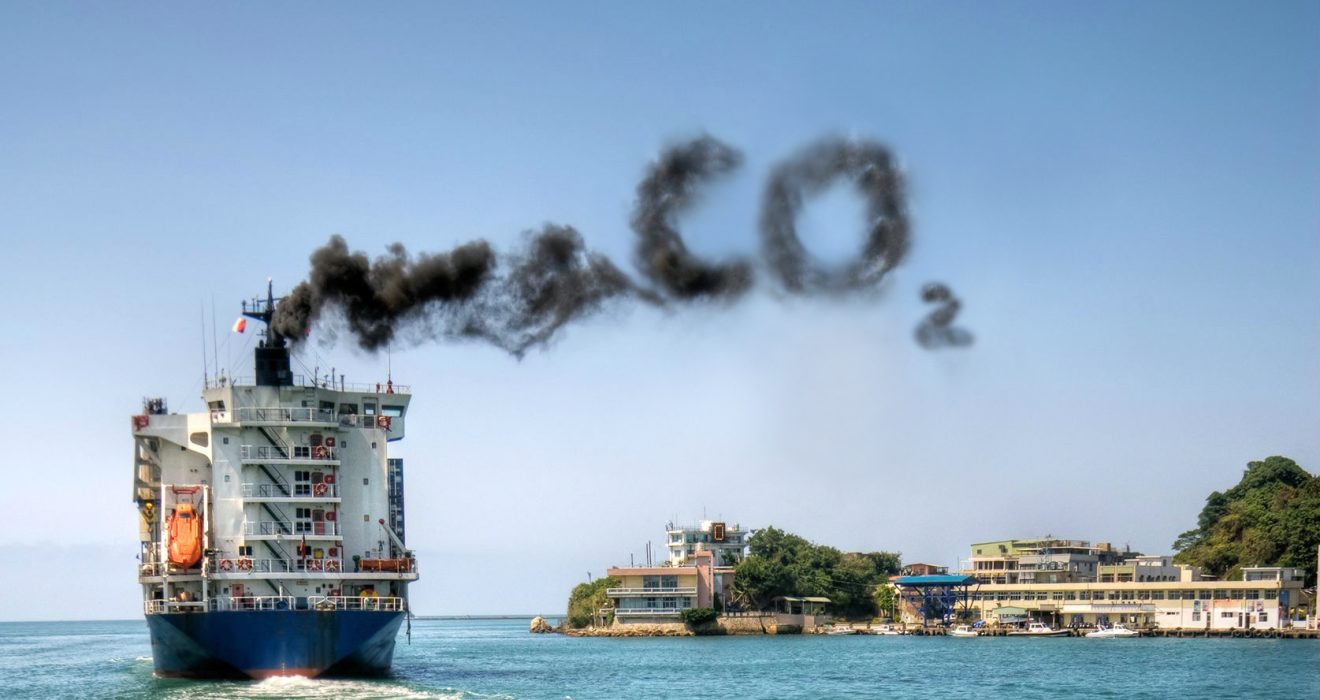Ships emit a considerable amount of carbon dioxide (CO2), accounting for around 3% of total human-caused CO2 emissions. With few alternatives for reducing their carbon impact, a unique technology suggests that ships could absorb CO2 emissions via a naturally occurring chemical reaction. This process includes bubbling exhaust through saltwater and limestone, converting CO2 to stable bicarbonate minerals that may be released back into the ocean. However, the environmental consequences of this method are uncertain.
The Chemical Mechanism:
For billions of years, the ocean has regulated atmospheric CO2 levels through a natural interaction between CO2 and calcium carbonate (limestone). This mechanism is crucial for maintaining the carbon balance in the Earth’s atmosphere and oceans. When water accumulates CO2, it turns acidic. This increased acidity promotes the dissolution of calcium carbonate, also known as limestone, into its ions. The dissolved limestone subsequently combines with the carbon dioxide (CO2) in the water, producing bicarbonate (HCO3-) crystals that can survive in the ocean for centuries. This process is an organic process that assists the planet in eliminating carbon dioxide (CO2) from its atmosphere over extended periods, and it is an important part of the worldwide carbon cycle.
Researchers discovered that raising the concentration of carbon dioxide (CO2) absorbed by limestone could accelerate the natural process. According to Jess Adkins of Calcarea, the startup behind the technology, employing pure CO2 accelerates the process by an order of magnitude. By artificially increasing this process, more carbon dioxide can converted into persistent bicarbonate minerals more quickly and efficiently.
Model Development and Testing:
Adkins and his colleagues created prototypes to demonstrate the viability of this method. Tests in California demonstrated that these early versions could turn at least 30% of the carbon dioxide (CO2) in the exhaust of diesel engines into bicarbonate. This positive outcome prompted additional cooperation with the research department of Lomar Shipping, a major shipping firm, to test the technology on a ship.
The on-board testing involves squashing the engine exhaust and running it through significant amounts of seawater. The motion of the ship functions as an organic water pump, lowering energy use. The highly acidic seawater then streams over crushed limestone, producing bicarbonate, which then flows back into the ocean. This system is intended to be more environmentally friendly and adaptable than existing carbon capture methods.
Traditional techniques frequently necessitate storing captured pollutants on board and discharging them at specialized ports which may be logistically demanding and space-intensive. whereas the Calcarea system incorporates carbon dioxide capture and conversion immediately into the vessel’s operations. Despite its effectiveness, the system is estimated to use approximately 4% of the space on a big bulk carrier ship over a long cruise. This space need is relatively small compared with other capture of carbon technologies.
Possible Challenges and Environmental Issues:
Phil Renforth of the Heriot-Watt University in the United Kingdom identifies many potential issues with this technique. One key concern is the system’s overall efficiency. While preliminary designs have demonstrated that 30% of CO2 can be recovered, absorbing full CO2 from exhaust gasses will certainly necessitate impractically massive reactors. Scalability is also an issue. As the reactor size rises, so does the system’s complexity and cost. Furthermore, as other low-emission cargo fuels become accessible, these alternatives could turn out to more efficient and feasible than absorbing emissions using this technology.
While releasing bicarbonates into water bodies is not a worry due to their natural presence in ocean water, additional substances in the exhaust may harm marine ecosystems. For example, ship exhaust gases contain not just CO2, but also other pollutants including sulfur oxides (SOx) and nitrogen oxides (NOx). Many ships already use devices to release sulfur pollutants from their exhaust into the water, raising regulatory and environmental issues. The long-term consequences of regularly dumping treated ocean water back into the deep sea must properly investigated to guarantee that aquatic creatures and habitats are not harmed.
Legal and Administrative Aspects:
Implementing this CO2 collecting technique on a broad scale would necessitate extensive legislative and logistical planning. The organizations that supervise global transportation and international seas have yet to achieve an agreement on the governance of CO2 storage projects at sea. World marine rules and regulations, such as those implemented by the International Maritime Organization (IMO), would have to amended to allow for and govern the use of such technologies. Furthermore, the logistics of setting up and operating these systems on ships, educating sailors to use them, and assuring compliance with environmental requirements must be addressed.
Broader Consequences and Prospects:
The use of this CO2-absorbing technique could have a significant impact on the maritime sector. Shipping businesses that reduce their carbon footprint may be able to comply with more strict environmental laws while also avoiding carbon taxes and fines. This technology may help improve the sector’s public perception by showing its dedication to conservation and environmental stewardship. However, the economic ramifications, particularly the expenses of setting up and sustaining the system, must be carefully considered.
If properly implemented, this technique could help to reduce global climate change by lowering carbon dioxide (CO2) from one of the key sources. The method, which converts CO2 into persistent bicarbonate minerals, not only cuts emissions but also aids in the long-term sequestration of carbon. This may help to mitigate some of the effects of acidification of the oceans, which endangers marine life and environments.
Conclusion:
The proposed method of absorbing carbon dioxide (CO2) from ships and turning them into persistent bicarbonate minerals using a natural marine reaction is novel and promising. It uses a well-known chemical technique to potentially lower the shipping industry’s carbon footprint dramatically. However, issues regarding effectiveness, adaptability, and environmental effects must be solved. Additional research, regulatory talks, and full environmental studies will be required to determine the practicality and acceptance of this technology on a broader scale. The successful deployment of this technology has the potential to significantly contribute to global efforts to prevent climate change and enhance maritime sustainability.

